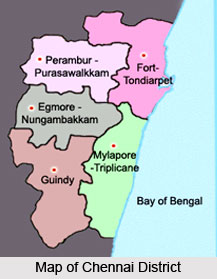 Originally Coimbatore district formed part of the Kongu country. The history dates back to the Sangam age. In early days tribes inhabited the area. The most predominant among them was the Kosars. They have had their headquarters at Kosampathur. It can be said, as this Kosampathur became the present Coimbatore. However, tribal predominance did not last long as they were over-run by the Rashtra Kutas. From Rashtrakutas the region was under the control of the Cholas who were in prominence at the time of Raja Chola. On the decline of Cholas the Kongu territory was occupied by the Chalukyas and then by the Pandyas and the cysalas respectively. Due to internal struggle in the Pandyan kingdom the Muslim rulers used to interfere from Delhi. Thus the area fell into the hands of Madurai Sultanate from whom the Vijayanagar rulers wrestled for the region during 1377-78 after overthrowing the Madurai Sultanate. For a few years the area remained under independent control of Madurai Nayaks.
Originally Coimbatore district formed part of the Kongu country. The history dates back to the Sangam age. In early days tribes inhabited the area. The most predominant among them was the Kosars. They have had their headquarters at Kosampathur. It can be said, as this Kosampathur became the present Coimbatore. However, tribal predominance did not last long as they were over-run by the Rashtra Kutas. From Rashtrakutas the region was under the control of the Cholas who were in prominence at the time of Raja Chola. On the decline of Cholas the Kongu territory was occupied by the Chalukyas and then by the Pandyas and the cysalas respectively. Due to internal struggle in the Pandyan kingdom the Muslim rulers used to interfere from Delhi. Thus the area fell into the hands of Madurai Sultanate from whom the Vijayanagar rulers wrestled for the region during 1377-78 after overthrowing the Madurai Sultanate. For a few years the area remained under independent control of Madurai Nayaks.
During the period of Muthu Veerappa Nayak and later during the period of Tirumal Nayak internal conflict and intermittent wars were th ereasons why the kingdom was ruined. As a consequence during the period of Tirumal Nayak, the Kongu region was under the control of the Mysore rulers from whom Hyder Ali took over the area. From then till 1947, at the time of India`s Independence, the region remained under British control that initiated systematic revenue administration in the area.
To begin with, Coimbatore was in two parts for the administration of revenue. In 1804, the areas were merged into one and brought under one District Collector. In 1868, the Nilgiris District was bifurcated from the Coimbatore District. At the opening of the present century there were ten taluks in the district viz., Bhavani, Coimbatore, Dharapuram, Erode, Karur, Kollegal, Palladam, Pollachi, Satyamangalam and Udumalaipettai. The name of Satyamangalam taluk was subsequently changed as Gopichettipalaiyam. Avinashi taluk was also formed. Karur taluk happened to be transferred to Tiruchirappalli district.
In 1927, Mettur Area was formed by some villages of Bhavani taluk together with a few villages from Salem district. But very soon i.e. in 1929, this area was transferred to Salem district. Again in the year 1956 considerable area of the district, viz., the whole of Kollegal taluk was transferred to Mysore State. This was the part of the States Re-organization Scheme. In 1975, Satyamangalam sub-taluk was upgraded as a full-fledged taluk. Again in 1979, Perundurai sub-taluk of Erode and Mettuppalaiyam sub-taluk of Avanashi were also upgraded into independent taluks. Thus the total number of taluks in the district came to twelve. But this arrangement did not last long. In the same year i.e. in 1979 six taluks were bifurcated from the district to constitute a new district viz., Erode. The following six taluks were bifurcated from the then Coimbatore district to form Erode district.
The names are as follows Bhavani, Gopichettipalaiyam, Satyamangalam, Erode, Perundurai and Dharapuram. This bifurcation considerably reduced the size of the district. Presently it has only nine taluks viz. Pollachi, Coimbatore(North), Avanashi, Palladam, Udumalpettai, Tirupur,Valparai,Coimbatore(South) and Mettuppalayam respectively.



















